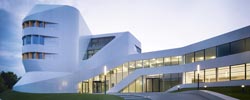Making research visible

Zentrum für Virtuelles Engineering in Stuttgart, Germany<br>Fraunhofer IAO <br>
When the “Zentrum für Virtuelles Engineering” ZVE opened in Stuttgart just over a year ago, we saw how Fraunhofer IAO had combined laboratory and office areas to create an architectural eye-catcher. A new publication provides insight into the innovative story of how this research building came about and features striking pictures that acknowledge its remarkable architecture and sustainability.
In creating the ZVE, Fraunhofer IAO has created a house of knowledge work in which Fraunhofer scientists can conduct interdisciplinary research relating to workplace design, future mobility, visual technologies and digital engineering. But it is more than its spectacular architecture that makes this one-year-old laboratory building stand out: the laboratory and office areas are designed to encourage new ideas, giving the Fraunhofer scientists a truly first-rate research facility.
Packed with pictures, interviews and a wealth of background information, the new book tells the ZVE’s whole story, taking the reader from the initial vision through planning and construction and on to the hive of activity that its laboratory and office areas are today. Impressive photos of the interior and exterior illustrate the research building’s unconventional architecture that mirrors the innovative power of the Fraunhofer scientists. The contoured lines of the building’s exterior bear the unmistakable signature of star architect Ben van Berkel, founder of Amsterdam-based architecture firm UNStudio, whose previous projects include designing the Mercedes Benz Museum in Stuttgart. In the new book, van Berkel recalls with excitement the ZVE’s remarkable evolution in walk-through 3D simulations: “Creating a virtual interior view of the designed rooms is something that used to take weeks; now it’s done in seconds, at the touch of a button.”
For scientists at Fraunhofer IAO, planning and building the ZVE was a research project in itself. Interdisciplinary project teams supported architects and planners as they worked to implement the vision of an innovation-stimulating work environment flowing seamlessly from office space to research laboratories and testing and demonstration areas. This novel layout allowed the scientists to put their latest insights into practice and provides them with a location in which to experience and shape the future of work itself.
An entire chapter of the book has been devoted to the topic of sustainability. The ZVE is one of the few buildings in Germany to have been awarded a gold certificate by the German Sustainable Building Council (DGNB) in recognition of its innovative contribution to energy efficiency and sustainability. Alongside the purely technical aspects of how the ZVE is constructed, the book also contains fascinating pictures of the laboratories and the topics being researched there.
Media Contact
All latest news from the category: Interdisciplinary Research
News and developments from the field of interdisciplinary research.
Among other topics, you can find stimulating reports and articles related to microsystems, emotions research, futures research and stratospheric research.
Newest articles

NASA: Mystery of life’s handedness deepens
The mystery of why life uses molecules with specific orientations has deepened with a NASA-funded discovery that RNA — a key molecule thought to have potentially held the instructions for…

What are the effects of historic lithium mining on water quality?
Study reveals low levels of common contaminants but high levels of other elements in waters associated with an abandoned lithium mine. Lithium ore and mining waste from a historic lithium…

Quantum-inspired design boosts efficiency of heat-to-electricity conversion
Rice engineers take unconventional route to improving thermophotovoltaic systems. Researchers at Rice University have found a new way to improve a key element of thermophotovoltaic (TPV) systems, which convert heat…



